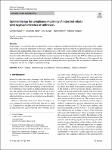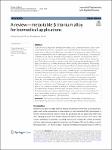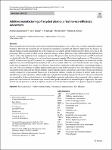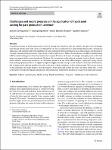Search
Author
- Amir, Ebrahimi (2)
- Aydin, Azizi (2)
- George, Haller (2)
- James, M. Fiore (2)
- next >
Subject
- robotics (9)
- Engineering (8)
- engineering (8)
- công nghệ (3)
- next >
Date issued
- 2020 - 2023 (215)
- 2010 - 2019 (28)
- 2001 - 2009 (6)
Has File(s)
- true (249)
Search Results
This article discusses challenges, experiences and lessons learned so far while transforming a masonry build system based mostly on manual labour into a robot automated build system. Our motivation for selection of this masonry process is to try out how robot automation could impact the architects in their design work by providing a tool to directly manipulate wall expression down to individual brick level. Such manipulation is often much too costly for manual labour today. Moreover, masonry is a challenging application to automate. Understanding the manual processes involved and transforming them into automation equivalents faces several challenges; among them handling and distribution of the different materials involved, selection of tooling, sensing for handling of variation and ... |
The complete description of outdoor luminous and thermal environment is the basis for daylight utilization design with simulation tools. Nevertheless, Typical Meteorological Year (TMY) and generation method specifically developed for the energy simulation of daylight-utilized buildings is still unavailable currently. Luminous environment parameters have not been taken into consideration in existing TMY generation methods. In this study, the feasibility of existing TMY generation process has been examined. A generic office model implementing sided window daylighting is established. |
Articulating crane (AC), a widely used crane, plays an essential role in various industrial activities. Owing to its strong nonlinearity and uncertainty, its tracking control remains challenging, particularly for precise dynamic tracking control. This paper proposes an adaptive diffeomorphism-constraint-based control (ADCBC) for a nonlinear AC to robustly achieve trajectory tracking while guaranteeing desired dynamic control performance (DDCP), considering (possibly rapid and irregular) time-variant uncertainty with unknown bounds. A user-definable hard-limiting function was used to guarantee the DDCP, including the requirement for steady-state tracking error and dynamic convergence speed. The desired trajectories and DDCP were formulated as equality and inequality servo constraints... |
The development of a planar manipulator with flexure joints and redundant actuation has been considered before, showing that the redundancy can be exploited to increase the support stiffness and to reduce static actuator loads. In this previous design the manipulator’s workspace has been defined to encompass all kinematically accessible end effector positions. In the current paper we reconsider the design philosophy. It will be shown that limiting the workspace (“less”) ultimately results in a better performance in a larger area (“more”). |
Cyclic load is widely adopted in laboratory to simulate the effect of train load on ballast bed. The effectiveness of such load equivalence is usually testified by having similar results of key concerns of ballast bed, such as deformation or stiffness, while the consistency of particle scale characteristics under two loading patterns is rarely examined, which is insufficient to well-understand and use the load simplification. In this study, a previous laboratory model test of ballast bed under cyclic load is rebuilt using 3D discrete element method (DEM), which is validated by dynamic responses monitored by high-resolution sensors. |
In this paper a cost and time efficient approach to setup a compliance model for industrial robots is presented. The compliance model is distinctly determined by the gear’s stiffness parameters which are tuned by an optimal design of experiments approach. The experimental setup consists of different poses of the robot’s axes together with the applied force at the tool center point (TCP). These robot poses represent together with defined forces the experimental setup where the deviation of the robot under defined force is measured. Based on measurements of the displacement of the TCP the stiffness parameters for the compliance model are estimated and afterwards validated in new experiments. The efficiency of this approach lies in the reduced amount of experiments that are needed to i... |
In smart grid, the neighborhood area network (NAN) serves as a bridge connecting smart meters and meter data management system (MDMS) and is one of the most important components of the smart grid communication network. In this work, we study the energy-efficient data transmissions from NAN gateways (i.e., routers) to the concentrator that connects the MDMS. Particularly, to assure that each router associated with diverse number of associated smart meters can achieve a required data rate, a set of proportional rate fairness constraints are imposed into the optimization problem. In this case, an optimization problem that balances energy efficiency and fairness is formulated. |
Titanium and its alloys have already been widely used as implant materials due to their outstanding mechanical characteristics and biocompatibility. Notwithstanding this, researchers and businesses alike have continued to actively pursue superior alloys since there are still problems which need urgent consideration. One of these is a noteworthy difference in the implant material’s elastics modulus and that of natural bone, which result into an issue of stress shielding. With prolonged use Ti alloys releases dangerous ions. The Ti alloy surface has a low bioactivity, which prolongs the healing process. β-Ti alloys could be used as viable alternatives when creating dental implants. |
Plastic materials have been widely used to replace metals in functional parts due to their lower cost and comparable technical properties. However, the increasing use of virgin plastic material in consumer and industrial applications has placed a significant burden on waste management due to the volume of waste created and the potential negative effects of its end-of-life processing. There is a need to adopt circular economy strategies such as plastic recycling within industrial applications in order to reduce this significant waste management pressure. The present study used recycled polylactic acid (PLA) material as a feedstock for the 3D printing of a centrifugal semi-open pump impeller. The technical performance of 3D printed recycled PLA material and virgin PLA material was com... |
Conventional means of producing material via metal casting have long been used for centuries. In spite of its advantages in producing durable parts with lower cost implications and the accommodation of large part production, this conventional approach is still characterized by the challenges of high lead time in patterns production, poor surface finish, and the need for secondary manufacturing operations, which always leads to material loss. Hence, the introduction of additive manufacturing (AM) to metal casting process has been immensely recognized because of its huge advantages in negating some of the challenges encountered in the conventional route. However, the inconsistency in the material properties (such as density, strength, elastic modulus, dimensional accuracies, surface f... |









